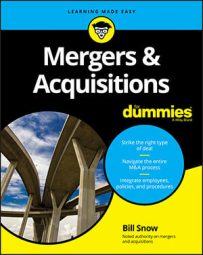Following the executive summary of the M&A offering document, you should include a section of company background. In addition to the company’s history and ownership information, you should include the following information:
The company’s past and present
An accurate assessment of the company’s history (good, bad, or in between) is a necessary part of the offering document. Having a solid understanding of where a company came from and how it developed can help Buyer understand the company.
Consider the following questions as you write this section of the offering document:
How was the company founded, and how did it grow? Is it still growing or has it run into some recent challenges?
What are the great successes and the problems, and how did the company overcome those problems?
What is the company’s current situation?
A timeline is a great way to point out key events in a company’s history: new products, financial milestones, past acquisitions, and so on.
Ownership and legal entity
Who are the owners, what do they own, and how much does each owner own? Another important consideration is what type of entity the company is. Is it an LLC, S-corp, or C-corp? Should any other affiliated or related entities be a part of an offer (or should they not)?
If Buyer is buying the stock of Seller’s company, Buyer needs to understand what entity owns what assets. For varying (often tax-related) reasons, a company may be comprised of two or more related entities. Buyer needs to make sure the stock he is buying actually has title to the assets of Seller’s business.
Employee info and benefits
For many (if not most) companies, the largest, single expense is personnel, so not surprisingly, a discussion of people, pay, and job duties is mandatory in the deal book.
List the total number of employees, the headcount per department, and provide salary and wage ranges per employee, department, or employee type. Include bios for the key employees, which typically are the executives, key managers, and perhaps certain other employees (such as sales and product development).
Also provide detail on the health plans, retirement plants (401k and the like), and vacation, sick day, and holiday policies. These plans may or may not match with Buyer’s company, so Buyer needs time to plan accordingly and make adjustments if warranted.
If Seller owes employees a certain amount of vacation time, Buyer may insist that the value of that vacation time be deducted from the sale price. The value of this vacation time is on the balance sheet in the liabilities section, most often called “accrued vacation”.
Locations of offices and facilities
The offering document needs to list all distribution and manufacturing facilities, including square footage as well as the number of employees at each location. Buyer may need this information as it considers how best to integrate the acquisition and the parent company.
Seller should list any and all remote workers, the city where each person resides, and a description of the person’s duties.
Real estate
If Seller owns the real estate where the facility is located, she may be interested in selling the business but retaining the property and having the new owner pay rent. This situation is very common and in many cases is Buyer’s preferred method. If Seller wants to sell the land as part of the deal, that sale is usually a separate deal.
Technology
Buyers need to know Seller’s computer systems, software, phone systems, websites, domain names, and anything else technology related.
Legal disclosures
Major areas of legal disclosure include safety, environmental, and tax issues. The company should mention any lawsuits to which it’s a party. If there are no specific issues, Seller says, “Ownership has no knowledge of any problems” or “Ownership believes it’s in compliance with . . . .”
Sellers should speak with their legal advisors about proper wording of any legal disclosure.

